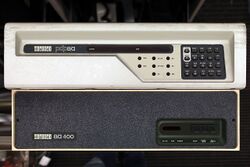Difference between revisions of "PDP-8/A"
From Computer History Wiki
(+) |
m (→Eternal links: +manuals) |
||
| Line 41: | Line 41: | ||
==Eternal links== | ==Eternal links== | ||
| + | * [http://www.bitsavers.org/pdf/dec/pdp8/pdp8a/ PDP-8/A] - documentation at [[Bitsavers]] | ||
| + | * [http://www.vandermark.ch/pdp8/uploads/PDP8/PDP8.Manuals/EK-8A002-MM-002.pdf PDP-8/A Miniprocessor Users Manual] (EK-8A002-MM-002) | ||
* [http://www.faqs.org/faqs/dec-faq/pdp8-models/section-11.html PDP-8 Summary of Models and Options - What is a PDP-8/A?] | * [http://www.faqs.org/faqs/dec-faq/pdp8-models/section-11.html PDP-8 Summary of Models and Options - What is a PDP-8/A?] | ||
Revision as of 16:17, 11 May 2023
| PDP-8/A | |
 PDP-8/A-400 | |
| Manufacturer: | DEC |
|---|---|
| Architecture: | PDP-8 |
| Year Introduced: | 1976 |
| Form Factor: | minicomputer |
| Word Size: | 12 |
| Logic Type: | TTL |
| Clock Speed: | 666KHz |
| Memory Speed: | 2.3 µseconds |
| Physical Address Size: | 32KW (requires optional KM8-A) |
| Virtual Address Size: | 4KW |
| Memory Management: | bank selection, CPU mode |
| Bus Architecture: | OMNIBUS |
| Operating System: | OS/8, TSS/8 |
| Predecessor(s): | PDP-8/E |
| Successor(s): | None |
| Price: | US$2.6K (CPU. 4KW memory, Operator's Panel) |
The PDP-8/A was DEC's last non-microprocessor PDP-8. The KK8-A CPU was a single hex board (M8315), which plugged into an OMNIBUS backplane. It supported both core main memory (MM8-AA, H219A/G649; and MM8-AB, H219B/G650) and semiconductor (MS8-A, M8311).
There were a number of options available for use with the -8/A, including:
- KM8-A Extended Option - main memory extension, time-sharing control, bootstrap ROM, etc
- DKC8-AA - front panel control, real-time clock, asynchronous serial line interface, parallel port, etc
- FPP8/A Floating Point Processor
The -8/A could use either an Operator's Panel, or a KC8-AA Programmer's Panel (similar to the KY11-LB); the latter required the DKC8-AA.
The -8/A came either as a kit of boards, or as a complete system including a chassis, power supply and backplane; in the latter form, there was a list of different configurations.
Eternal links
- PDP-8/A - documentation at Bitsavers
- PDP-8/A Miniprocessor Users Manual (EK-8A002-MM-002)
- PDP-8 Summary of Models and Options - What is a PDP-8/A?
| v • d • e PDP-8 Computers, Software and Peripherals |
|---|
| PDP-8s: PDP-5 • PDP-8 • LINC-8 • PDP-8/S • PDP-8/I • PDP-8/L • PDP-12 • PDP-8/E • PDP-8/F • PDP-8/M • PDP-8/A
Workstations: VT78 Also: PDP-8 family • PDP-8 architecture • PDP-8 Memory Extension units |